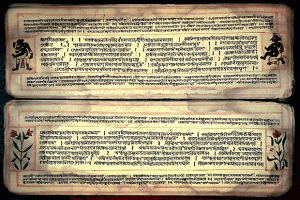P U R A N A S

> Hinduism: A Holistic Way of Life <
The Hindu Vedas & Puranas elucidate on not only theology and mytho
Yoga is a way of life, an art of righteous living or an integrated system for the benefit of the body, mind and inner spirit. This art originated, was perfected and practiced in India thousands of years ago.
The references to yoga are available in > ‚Upanishads‘ < and > ‚Puranas‘ < composed by Indian Aryans in the later Vedic and post- Vedic period.
The main credit for systematizing yoga goes to Patanjali who wrote ‚Yoga Sutra‘, two thousand Years ago.
He described the principles of the full eight fold yogic discipline. He composed the treatise in brief code words known as ‚Sutras‘.
Yoga is a way of life, an art of righteous living or an integrated system for the benefit of the body, mind and inner spirit. This art originated, was perfected and practiced in India thousands of years ago. The references to yoga are available in ‚Upanishads‘ and ‚Puranas‘ composed by Indian Aryans in the later Vedic and post- Vedic period.
The main credit for systematizing yoga goes to Patanjali who wrote ‚Yoga Sutra‘, two thousand Years ago. He described the principles of the full eight fold yogic discipline. He composed the treatise in brief code words known as ‚Sutras‘. > ‚Yoga Sutra‘ < is the most important basic text on Yoga. It is through this basic treatise that the essential message of yoga spread throughout the world.
Aim of Yoga is the attainment of the physical, mental and spiritual health. Patanjali has recommended eight stages of Yoga discipline. They are:
-
Yamas- Yamas (abstentions or restrains)
-
Niyamas- Niyamas (observances)-austerities, purity, contentment, study, surrender of the ego
-
Asanas- Physical postures or exercises
-
Pranayama- Control of vital energy (Breathing control)
-
Partyahara- Withdrawal of the senses
-
Dharana- Concentration of the mind (Contemplation)
-
Dhyana- Meditation
-
Samadhi- Attainment of The super conscious state
Quelle Astrojyothi: > The Puranas < are the richest collection of mythology in the world. Most of them attained their final form around 500 A.D. but they were passed on as an oral tradition since the time of Krishna (c. 1500 B.C.).
There are eighteen major Puranas and a few minor ones. Each is a long book consisting of various stories of the Gods and Goddesses, hymns, an outline of ancient history, cosmology, rules of life, rituals, instructions on spiritual knowledge. Hence the Puranas are like encyclopedias of religion and culture and contain material of different levels and degrees of difficulty.
The most important Puranas are the VISHNU PURANA, SHIVA PURANA and MARKENDEYA PURANA (to the Goddess). The BHAGAVATA PURANA is important to the worshippers of Krishna. Other Puranas are the Vayu, Agni, Skanda, Kalki, Linga.
„The Vedas and Puranas are one and the same in purpose. They ascertain the Absolute Truth, which is greater than everything else. The Absolute Truth is ultimately realized as the Absolute Personality of Godhead with absolute controlling power. As such, the Absolute Personality of Godhead must be completely full of opulence, strength, fame, beauty, knowledge and renunciation.“
The Puranas are perhaps the most important or commonly used scriptural texts of the Hindus. They were guide books for the whole of life and society.
- Dein Ayurveda Net: ….. > “ Patanjali „ <
- Dein Ayurveda Net: ….. > “ Ashtanga “ <
- Dein Ayurveda Net: ….. > “ Purana “ <
- Dein Ayurveda Net: ….. > “ Agama“ <
- > Meet Patanjali Groups at facebook <
- > Meet Upanishad Groups and Study at facebook <
Comments are closed.